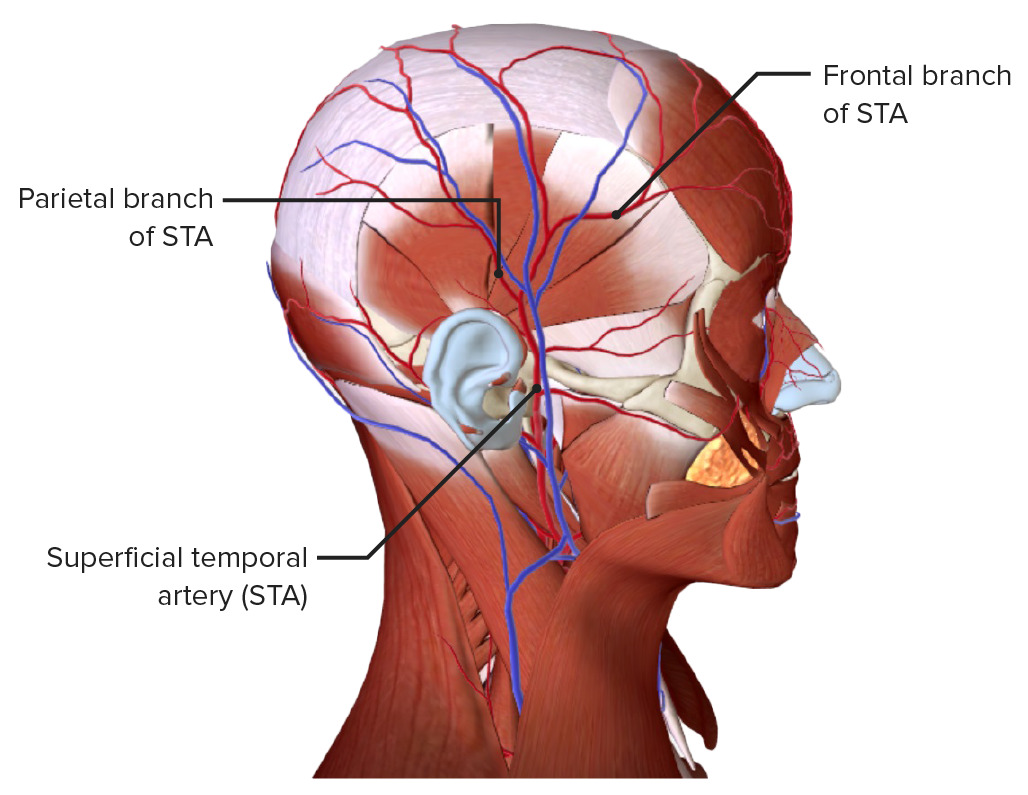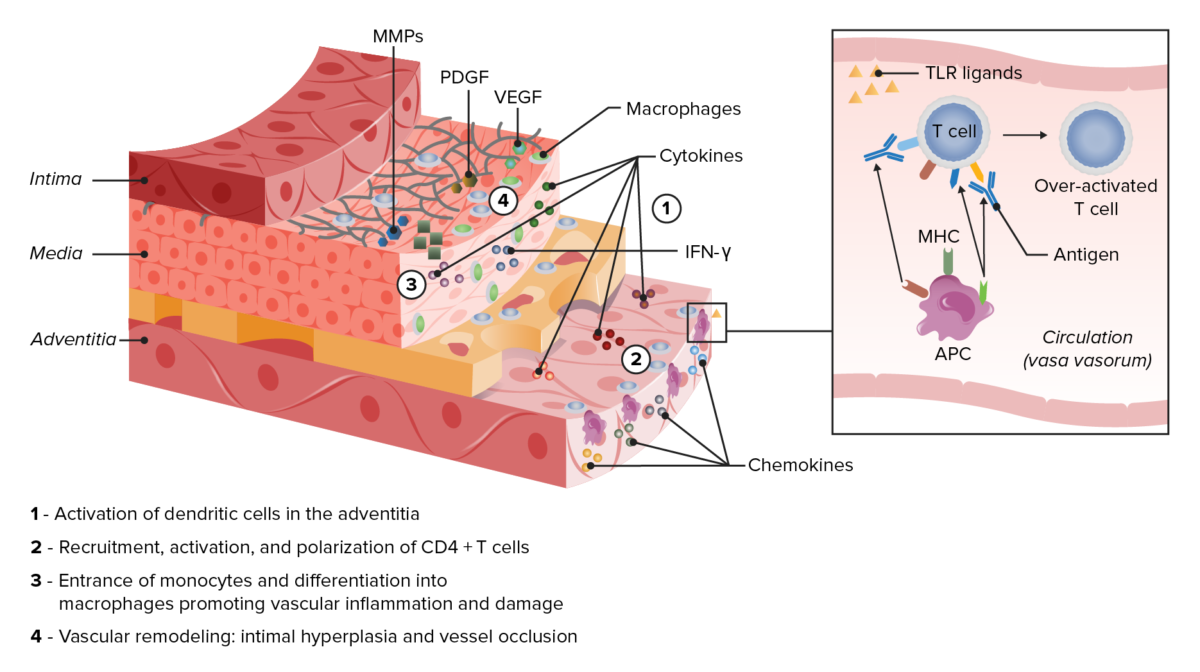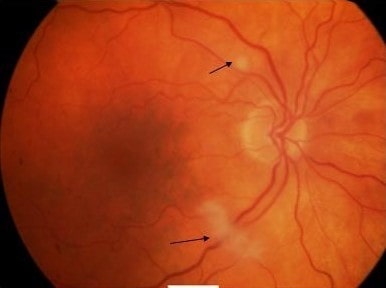Giant cell arteritis Giant Cell Arteritis Giant cell arteritis (GCA), also known as temporal arteritis, is a type of large-vessel vasculitis that predominantly affects the aorta and its major branches, with a predilection for the branches of the carotid (including the temporal artery). Giant cell arteritis is defined by inflammatory leukocytes in the vessel walls leading to reactive damage, ischemia, and necrosis. Giant Cell Arteritis ( GCA GCA Giant cell arteritis (GCA), also known as temporal arteritis, is a type of large-vessel vasculitis that predominantly affects the aorta and its major branches, with a predilection for the branches of the carotid (including the temporal artery). Giant cell arteritis is defined by inflammatory leukocytes in the vessel walls leading to reactive damage, ischemia, and necrosis. Giant Cell Arteritis), also known as temporal arteritis Temporal arteritis Giant cell arteritis (GCA), also known as temporal arteritis, is a type of large-vessel vasculitis that predominantly affects the aorta and its major branches, with a predilection for the branches of the carotid (including the temporal artery). Giant cell arteritis is defined by inflammatory leukocytes in the vessel walls leading to reactive damage, ischemia, and necrosis. Giant Cell Arteritis, is a type of large-vessel vasculitis Vasculitis Inflammation of any one of the blood vessels, including the arteries; veins; and rest of the vasculature system in the body. Systemic Lupus Erythematosus that predominantly affects the aorta Aorta The main trunk of the systemic arteries. Mediastinum and Great Vessels: Anatomy and its major branches, with a predilection for the branches of the carotid (including the temporal artery). Giant cell arteritis Giant Cell Arteritis Giant cell arteritis (GCA), also known as temporal arteritis, is a type of large-vessel vasculitis that predominantly affects the aorta and its major branches, with a predilection for the branches of the carotid (including the temporal artery). Giant cell arteritis is defined by inflammatory leukocytes in the vessel walls leading to reactive damage, ischemia, and necrosis. Giant Cell Arteritis is defined by inflammatory leukocytes Leukocytes White blood cells. These include granular leukocytes (basophils; eosinophils; and neutrophils) as well as non-granular leukocytes (lymphocytes and monocytes). White Myeloid Cells: Histology in the vessel walls leading to reactive damage, ischemia Ischemia A hypoperfusion of the blood through an organ or tissue caused by a pathologic constriction or obstruction of its blood vessels, or an absence of blood circulation. Ischemic Cell Damage, and necrosis Necrosis The death of cells in an organ or tissue due to disease, injury or failure of the blood supply. Ischemic Cell Damage. Giant cell arteritis Giant Cell Arteritis Giant cell arteritis (GCA), also known as temporal arteritis, is a type of large-vessel vasculitis that predominantly affects the aorta and its major branches, with a predilection for the branches of the carotid (including the temporal artery). Giant cell arteritis is defined by inflammatory leukocytes in the vessel walls leading to reactive damage, ischemia, and necrosis. Giant Cell Arteritis causes headaches, scalp tenderness, jaw Jaw The jaw is made up of the mandible, which comprises the lower jaw, and the maxilla, which comprises the upper jaw. The mandible articulates with the temporal bone via the temporomandibular joint (TMJ). The 4 muscles of mastication produce the movements of the TMJ to ensure the efficient chewing of food. Jaw and Temporomandibular Joint: Anatomy pain Pain An unpleasant sensation induced by noxious stimuli which are detected by nerve endings of nociceptive neurons. Pain: Types and Pathways, vision Vision Ophthalmic Exam problems, and potentially blindness Blindness The inability to see or the loss or absence of perception of visual stimuli. This condition may be the result of eye diseases; optic nerve diseases; optic chiasm diseases; or brain diseases affecting the visual pathways or occipital lobe. Retinopathy of Prematurity. The diagnosis is made with temporal artery biopsy Temporal Artery Biopsy Giant Cell Arteritis. Prompt treatment with glucocorticoids Glucocorticoids Glucocorticoids are a class within the corticosteroid family. Glucocorticoids are chemically and functionally similar to endogenous cortisol. There are a wide array of indications, which primarily benefit from the antiinflammatory and immunosuppressive effects of this class of drugs. Glucocorticoids can relieve symptoms and prevent vision Vision Ophthalmic Exam loss.
Last updated: Jun 7, 2025
Giant cell arteritis Giant Cell Arteritis Giant cell arteritis (GCA), also known as temporal arteritis, is a type of large-vessel vasculitis that predominantly affects the aorta and its major branches, with a predilection for the branches of the carotid (including the temporal artery). Giant cell arteritis is defined by inflammatory leukocytes in the vessel walls leading to reactive damage, ischemia, and necrosis. Giant Cell Arteritis ( GCA GCA Giant cell arteritis (GCA), also known as temporal arteritis, is a type of large-vessel vasculitis that predominantly affects the aorta and its major branches, with a predilection for the branches of the carotid (including the temporal artery). Giant cell arteritis is defined by inflammatory leukocytes in the vessel walls leading to reactive damage, ischemia, and necrosis. Giant Cell Arteritis) is caused by a complicated cascade of vascular inflammation Inflammation Inflammation is a complex set of responses to infection and injury involving leukocytes as the principal cellular mediators in the body’s defense against pathogenic organisms. Inflammation is also seen as a response to tissue injury in the process of wound healing. The 5 cardinal signs of inflammation are pain, heat, redness, swelling, and loss of function. Inflammation, damage, and dysfunctional repair:

Branches of the STA, which may be involved in GCA
Image by BioDigital, edited by Lecturio.
Elastic stains on the same case of a histologically positive temporal artery biopsy showing the fragmentation, distortion, and lack of continuity of the internal elastic lamina, a characteristic feature of temporal arteritis
Image: “Association between human papillomavirus DNA and temporal arteritis” by Mohammadi, A., Pfeifer, J.D., Lewis, J.S. License: CC BY 2.0.
Pathophysiology in giant cell arteritis
Notice the activation of T cells through presentation of an antigen by dendritic cells (APC). These recruit and activate more inflammatory cells, including macrophages, through toll-like receptor ligands (TLR), cytokines, and chemokines. Macrophages will organize into giant cells, and produce matrix metalloproteinases (MMPs) and growth factors (PDGF and VEGF). This causes the destruction and hyperplasia that will eventually cause vessel occlusion.
Symptom onset is typically subacute, developing over weeks to months. More abrupt presentations, with symptoms arising over a few days; occurs in a minority of cases.

Fundoscopy of the right eye, showing cotton-wool spots along the superotemporal and inferotemporal arterioles (arrows). The cotton-wool spots denote obstruction of the retinal arterioles, leading to retinal ischemia.
Image: “Cotton-wool spots” by James Paget University Hospital NHS Foundation Trust, Lowestoft Road, Gorleston, Great Yarmouth NR31 6LA, Norfolk, UK. License: CC BY 2.0.
The above is a simple algorithm to help aid in the diagnosis of GCA. This outlines when this disease should be considered, and the basic steps in diagnosis.
Image by Lecturio.1st, check laboratory studies:[6,8]
Next steps:[6,8,10,13]

Biopsy of temporal artery showing transmural mixed inflammatory cell infiltrates with intimal thickening, fragmentation, and distortion of the internal elastic lamina
Image: “Biopsy of temporal artery” by the Department of Pathology and Laboratory Medicine, University of Florida, College of Medicine, Jacksonville, FL, USA. License: CC BY 2.0.If the above workup is not diagnostic, consider evaluation for large-vessel involvement:[6,8,10,13]
| Category | criteria | Points |
|---|---|---|
| Clinical | Morning stiffness affecting shoulders and/or neck Neck The part of a human or animal body connecting the head to the rest of the body. Peritonsillar Abscess | 2 |
| Sudden vision Vision Ophthalmic Exam loss | 3 | |
| Claudication of jaw Jaw The jaw is made up of the mandible, which comprises the lower jaw, and the maxilla, which comprises the upper jaw. The mandible articulates with the temporal bone via the temporomandibular joint (TMJ). The 4 muscles of mastication produce the movements of the TMJ to ensure the efficient chewing of food. Jaw and Temporomandibular Joint: Anatomy or tongue Tongue The tongue, on the other hand, is a complex muscular structure that permits tasting and facilitates the process of mastication and communication. The blood supply of the tongue originates from the external carotid artery, and the innervation is through cranial nerves. Lips and Tongue: Anatomy | 2 | |
| New temporal headache Headache The symptom of pain in the cranial region. It may be an isolated benign occurrence or manifestation of a wide variety of headache disorders. Brain Abscess | 2 | |
| Scalp tenderness | 2 | |
Abnormal findings of the temporal artery, such as:
|
2 | |
| Diagnostics | ESR ESR Soft Tissue Abscess ≥ 50 mm/hr or CRP ≥ 10 mg/L prior to initiation of treatment | 3 |
Either:
|
5 | |
| Bilateral axillary involvement on imaging | 2 | |
| FDG-PET activity throughout the aorta Aorta The main trunk of the systemic arteries. Mediastinum and Great Vessels: Anatomy | 2 |
It is very important not to delay treatment while awaiting biopsy Biopsy Removal and pathologic examination of specimens from the living body. Ewing Sarcoma results in order to minimize the risk of vision Vision Ophthalmic Exam loss. The following information is based on US and UK literature and guidelines. Management may vary based on practice location.
Systemic glucocorticoids Systemic Glucocorticoids Glucocorticoids are the mainstay of treatment, and treatment should be initiated promptly if there is a strong suspicion of GCA GCA Giant cell arteritis (GCA), also known as temporal arteritis, is a type of large-vessel vasculitis that predominantly affects the aorta and its major branches, with a predilection for the branches of the carotid (including the temporal artery). Giant cell arteritis is defined by inflammatory leukocytes in the vessel walls leading to reactive damage, ischemia, and necrosis. Giant Cell Arteritis.
Initial dosing:[8‒10,13]
Tapering:[8,9,13]
Side effects:[8,9,13]
Monitor with monthly follow-up visits (typically with a rheumatologist):[8,10,13]
In addition to receiving education on their diagnosis, patients Patients Individuals participating in the health care system for the purpose of receiving therapeutic, diagnostic, or preventive procedures. Clinician–Patient Relationship should also receive counseling related to: